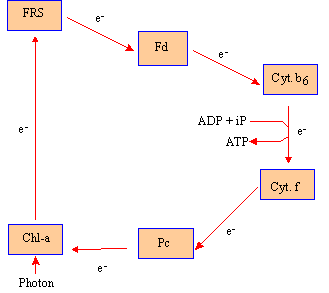|
PinkMonkey Online Study Guide-Biology
(2) Cyclic photophosphorylation
In the light reaction of photosynthesis, the formation
of ATP from ADP and H3PO4 in the presence
of light and chlorophyll-a during the cyclic transfer of electrons
is called cyclic photophosphorylation.
Important features
(1) It is a part of the light reaction of photosynthesis.
(2) It is a photochemical reaction and depends
on light.
(3) It takes place in the grana of chloroplasts.
(4) It requires participation of PS I only.
(5) The movement of electrons is cyclic.
(6) The cyclic process involves only ATP formation.
The various steps involved are as follows:
(a) Photoexcitation of PS I : The reaction
center of PS I (chl-a 700, i.e. P 700) is activated on receiving
light energy in the form of photons. In this excited state, the
chl-a of PS I expels an electron and becomes ionized chl-a.
(b) Cyclic electron transfer : The energy
rich electrons from the PS I are first accepted by FRS and transferred
to Fd. From Fd, the electrons are transferred to Cytochrome. b6
(and not to NADP), Cytochrome. f and then to PC. From PC the electrons
are finally accepted by the same ionized chl-a+ of PS
I. On receiving the lost electrons, the chlorophyll-a+
comes back to the ground state and can again participate in the
process.

Figure 4.5 Diagrammatic representation of the cyclic
process
In this process, the initial donor and the final
acceptor of electrons is the same chlorophyll-a of PS I. Hence,
the movement of electrons is cyclic.
(c) Synthesis of ATP : During the cycle
transfer of the energy-rich electrons, there is loss of electron
energy at each transfer. It is used at one such transfer for the
formation of ATP from ADP and H3PO4 . This
is called cyclic photophosphorylation.
In the cyclic process, neither PS II or the photolysis
of water are involved. Hence, NADPH2 is not formed and
oxygen is not evolved.
Products of the light reaction : From the
foregoing account, it is very clear that the overall light reaction
consists of the non-cyclic and the cyclic photophosphorylation reactions.
The products of the light reaction (cyclic + non-cyclic) are ATP,
NADPH2 and O2. As stated earlier, the oxygen
is liberated from the green plants. ATP and NADPH2 are
used in the following dark reactions (phase-II) for the reduction
of cabon dioxide to form carbohydrates (carbon assimilation). Hence,
these products of the light reactions (ATP and NADPH2)
are called assimilatory power (Arnon).
|
Table of Contents
4.0
Introduction
4.1 Chloroplasts
4. 2 Overall Equation of Photosynthesis
4.3 Primary Process of Photosynthesis
4.4 Secondary Processes of Photosynthesis (Biochemical Phase, Dark Reaction)
4.5 Diversity in Photosynthesis Pathway
4.6 Significance of Photosynthesis
Chapter
5
|